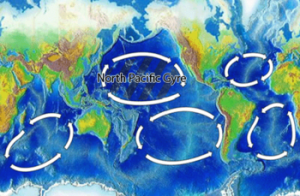In the one hundred years since the invention of plastic, it has become nearly impossible for any of us to make it through an hour, much less a day, without laying our hands on something made of the ubiquitous material. Taking a look around the SEANET office, plastic seems to loom everywhere. While we reduce our use of it as much as we can, and take advantage of the Town of Grafton’s very progressive recycling program, the fact remains that the vast majority of plastic used worldwide never makes it to a recycling plant. So what becomes of all that stuff?
One troublingly common destination for plastic of all sorts is the North Pacific Gyre, the becalmed waters once known as “the doldrums.” Amounting to an enormous soup-pot of plastics extending down well below the surface, the size of the garbage patch has never been accurately determined. A recent report in the Telegraph in Great Britain estimates that the patch may be twice the size of France.
The true implications for wildlife are as yet unknown; while seabirds and marine mammals can ingest the plastics and become obstructed by them, SEANET’s own research has shown that shearwaters commonly ingest numerous plastic pieces with no apparent ill effect. But physical obstruction is only one possible consequence of plastic ingestion, and issues such as toxic effects from plastics or endocrine disruption are woefully under-researched.
This issue is particularly timely as SEANET has introduced its new policy of tagging all beached bird carcasses with orange cable ties. We have had comments on this blog about the ethics of introducing still more plastic to the environment. We have tried to compromise and be sensitive to our volunteers’ concern by offering the alternative of discarding carcasses found on the beach so they will not be re-found by anyone else and recounted, falsely inflating our statistics. We also point out that scientific research on birds has long involved bird banding, which generates data unobtainable by any other means. Bird banding, like carcass marking, also introduces small pieces of plastic into the environment, but the scientific benefit is generally thought to outweigh the environmental detriment.
We welcome our volunteers’ thoughts and comments on any of SEANET’s protocols, and we appreciate everyone’s contributions to the lively debate we’ve been having on this subject. Keep it up, independent minded Seanetters! You keep us on our toes!

We have multiple Gyres on this map, does that mean that each of them has a garbage patch?
[…] other news, we received a comment on an earlier post regarding the Great Pacific Garbage Patch. Commenting on the map included with that post (shown again here), Chris wrote, “We have […]
[…] earlier post on the massive, swirling accumulation of junk out in the Pacific Ocean generated a good deal of […]